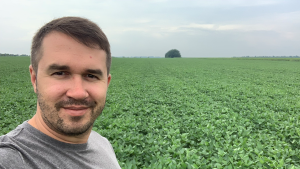Global economic challenges
WAR IN UKRAINE CAUSES FURTHER DISRUPTION

OVER THE PAST two years, there has been a considerable disruption in the global economy and agricultural markets. High costs of production, supply-chain challenges, inflation, geopolitics, and volatility in the markets continue to impact Ontario grain farmers. Throughout this growing season and into next year, grain farmers will be watching three key areas: high-input costs and shrinking margins, price volatility related to global grain supply and political instability, and commodity prices and interest rates.
| WHAT YOU NEED TO KNOW • The global COVID-19 pandemic has caused significant rise in input costs including fuel and fertilizer over the past two years. • The issue has been further exacerbated by the Russian invasion of Ukraine in February of 2022, causing fertilizer and fuel shortages and skyrocketing prices. • Global food prices have increased by 30 per cent in the first quarter of 2022, after increasing 30 per cent during the pandemic. Rising food inflation is causing an increase in global food insecurity. • Grain Farmers of Ontario continues to advocate for government support to help mitigate the risk that farmers face due to global economic and political pressure. |
HIGH INPUT COSTS
Input costs were rising before the pandemic and have shown no sign of slowing down. Shrinking margins despite high grain commodity prices are a function of the fixed costs required to run grain farms and the drastic increase in fuel and fertilizers.
According to the Ontario Ministry of Agriculture, Food and Rural Affairs, the overall cost of production has increased by 21.4 per cent for corn and 23 per cent for soybean growers since last year. Since the COVID-19 crisis began, the average cost of farm inputs has increased by 14 per cent, according to Statistics Canada’s Farm Input Price Index, with fuel and fertilizers being the primary drivers. These increases do not incorporate the indirect cost of the federal carbon tax, which increased by 102 per cent between 2019 and 2022, adding an additional $54 per acre.
Fuel prices, which had fallen at the start of the pandemic, have nearly doubled since then. Initially, the increase was driven by the easing of pandemic-related lockdowns and restrictions. Recent increases are driven by sanctions on Russia, and their inability to sell oil abroad is causing a global supply shortage.
Fertilizer prices in Canada, on average, have increased by 117 per cent since April 2021 and 42 per cent since the Russia-Ukraine war began. Increased global demand, energy costs (especially natural gas), and supply chain disruptions have contributed to increased prices. Additionally, China has slowed down or stopped production at many fertilizer plants to conserve electricity due to rolling blackouts and has blocked phosphate exports to protect local users from high global prices.
Canada has also imposed a 35 per cent tariff on fertilizer from Russia and Belarus and has barred Russian ships from docking at Canadian ports. These sanctions created supply challenges to spring fertilizer supplies in Ontario, Quebec and Atlantic Canada. Farmers were faced with uncertainty, not knowing fertilizer prices or if they could secure fertilizer supplies before planting began.
Discussions are underway in Canada to find alternative sources for key fertilizers. Solutions to sourcing alternatives will need to keep the economics in mind and the speed at which they can service the demand that has traditionally relied on Russia due to its lower energy costs.
While commodity prices for corn, soybeans, and wheat were higher going into planting season, profit margins will be affected by the substantial fuel and fertilizer costs, accounting for 38 per cent of costs. Looming concerns persist from farmers about the potential for input prices remaining high even after commodity prices have declined.
FOOD PRICE INFLATION
Global food prices increased 30 per cent in the first two years of the pandemic and an additional 30 per cent in the first quarter of 2022. Prices are rising and have exceeded the prices seen in the global food crisis of 2011, which led to widespread political instability in the hardest-hit nations. Price changes are often a function of short-term market forces adjusting to prevailing demand and supply conditions. In the early phase of the COVID-19 pandemic, food price increases were driven by global retail and food processing worker shortages. However, they continued to increase in 2021 and spiked in the first three months of 2022 despite labour shortages subsiding. Increased energy costs, shipping disruptions due to supply chain bottlenecks and container shortages, and reduced agriculture production from droughts in Brazil and Canada have also contributed to soaring prices.
The Food and Agriculture Organization Food Price Index does not reflect the full impact of the Invasion of Ukraine by Russia yet. It is estimated that 25 per cent of the global grain supply comes from the regions affected by the conflict and the retaliatory sanctions. Since the war began, Russia has blocked all ships in the Black Sea from leaving Ukraine, forcing the country to resort to transporting grain west via rail. Land mines, input shortages, and military assaults have impacted farmers, and according to the Ukrainian agriculture minister, the total 2022 harvest could be reduced by 50 per cent. The International Committee of the Red Cross says that 25 per cent of Africa’s population of 346 million is now food insecure due to price inflation and shortages driven by Russia’s invasion of Ukraine.
In April 2022, the government of Canada stated that “the invasion of Ukraine — and the significant sanctions imposed on Russia’s economy — have jolted commodity markets with a surge in prices. With sanctions likely to remain for some time and a longer-term strategic shift away from Russian resources in some parts of the world, certain commodity prices are poised to remain elevated and volatile. Due to global demand, prices and markets for Ontario grains and oilseeds are high. Political unrest from food insecurity and geopolitical position will continue to create volatile markets for Ontario grains.”
RECESSION IS POSSIBLE
The U.S. yield curve is threatening to invert, which can be a sign of a U.S. economic recession. A yield curve inversion happens when the interest rate on long-dated treasuries is lower than on short-dated U.S. treasuries. This is unnatural and usually occurs when investors sense the U.S. economy is in trouble and demand a higher return on short-term investments. Previous U.S. recessions were preceded by the yield curve inverting, with a downturn arriving after 17 months of the inversion. Historically, recessions in Canada have followed U.S. recessions since the Depression except for 1969 and 2001.
While recessions are a natural part of the economic cycle, the government of Canada and the Bank of Canada (BOC) try to ease the impact through investments and monetary policy. The BOC’s April 2022 economic statement forecasted growth in Canada’s economy for 2022 before a gradual slowing in 2023 and 2024. Since the post-pandemic recovery, inflation has been rising, and too much inflation can cause a recession. The BOC’s primary mandate is to keep inflation at two per cent by employing monetary policies by adjusting the policy interest rate over time. On April 13, the rate was increased by 0.5 per cent, with further rate hikes projected. The intended effect of the rate hike is to restrain borrowing, lowering consumer spending and inflation.
The impact of interest rate hikes and recession is another uncertainty for Ontario’s grain farmers. Commodity prices typically decline in a recession, but that may not be the case with the fragile geopolitical climate. Depending on the interest rates increases, servicing farm debt, which has doubled in Ontario in the last 10 years, could become challenging.
FINAL THOUGHTS
Farmers are accustomed to managing uncertainties in their farm businesses, and they rely on government support to manage risks outside of their control. Geopolitics, the ongoing invasion of Ukraine, and the post-pandemic economic recovery make the risks outside of farmers’ control greater than we have seen in the recent past. Farmers need the government to provide risk management solutions to help them grow more food in Canada as threats to global food security mount. AgriStability is not responsive to grain farmers facing the volatilities in the marketplace. Grain Farmers of Ontario has advocated for better BRM programming targeting price and margin decline and asked the Ontario government to increase the money available in the Risk Management Program (RMP). Ontario’s direct competitors in the United States have programs that work for them and give them a competitive advantage in the global market. In a world with so many uncertainties, a sustainably funded BRM program that responds to the risks grain farmers face would provide the security they need to invest in their business and grow the crops that produce food for people in Ontario and around the world.
Sankalp Sharma is the senior economist at Grain Farmers of Ontario. •

























